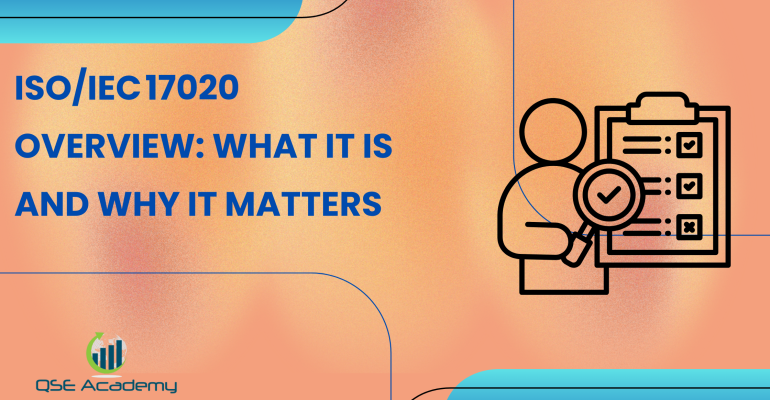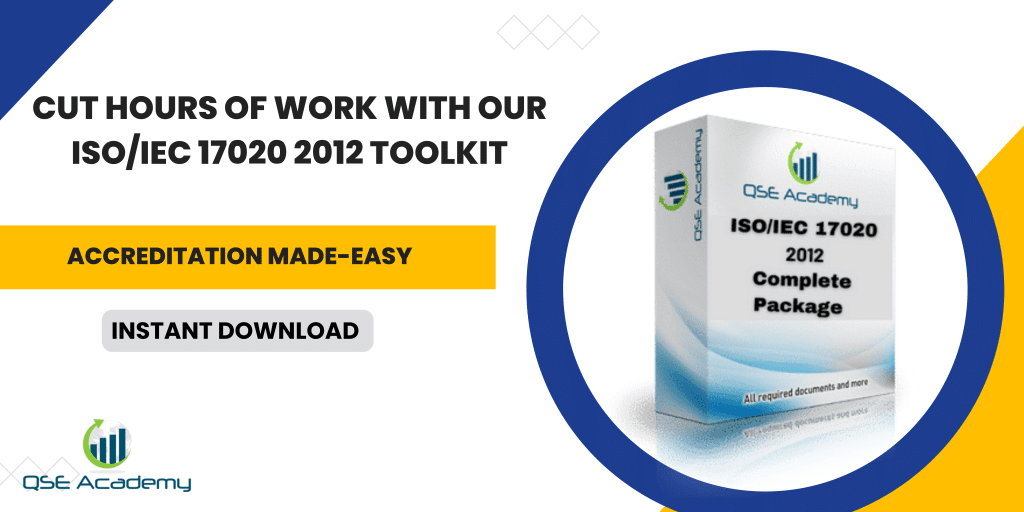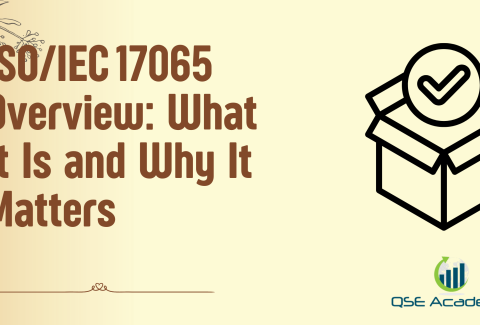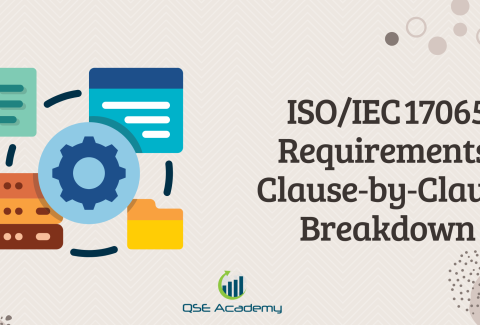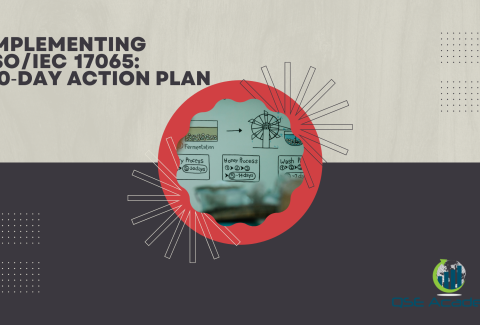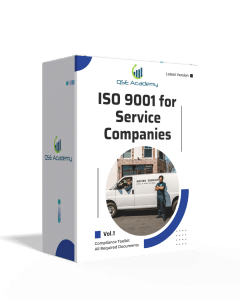ISO/IEC 17020 Overview: What It Is and Why It Matters
Last Updated on October 22, 2025 by Hafsa J.
Understanding the Real Purpose of ISO/IEC 17020
ISO/IEC 17020 is one of those standards that inspection bodies hear about early — but rarely understand completely.
Some see it as just another certificate to hang on the wall; others assume it’s meant only for big organizations. In truth, ISO/IEC 17020 is the international benchmark for trust and technical competence in inspection activities. It defines how inspection bodies prove that their work is impartial, consistent, and reliable enough to be recognized globally.
This pillar article is here to give you a full, plain-language understanding of what ISO/IEC 17020 is and why it matters. We’ll walk through its purpose, who it applies to, what makes it different from other standards, and how accreditation under it strengthens your organization’s credibility, operations, and reputation.
If you manage or operate an inspection body — whether independent or internal — understanding this standard is essential. ISO/IEC 17020 doesn’t just improve how inspections are performed; it sets the foundation for recognition, client confidence, and regulatory acceptance.
Think of this as your reference guide to understanding the entire ecosystem around ISO/IEC 17020. By the end, you’ll know exactly what the standard demands, how it builds trust, and why it remains the defining measure of quality for inspection bodies worldwide.
Now, let’s start by clarifying what ISO/IEC 17020 actually is — and the purpose it serves.
What Is ISO/IEC 17020? (Definition & Core Purpose)
ISO/IEC 17020 is the international standard that defines how inspection bodies demonstrate technical competence, impartiality, and consistency in their inspection work.
In plain language, it’s the rulebook that ensures inspection results can be trusted — whether they come from a private firm, a government agency, or an internal quality department.
The standard was developed by the International Organization for Standardization (ISO) and the International Electrotechnical Commission (IEC) to establish a single, globally recognized framework for inspection activities. Its main goal is to make sure that every inspection body, regardless of size or sector, works according to objective evidence, qualified judgment, and traceable methods.
Unlike standards that certify quality management systems (like ISO 9001), ISO/IEC 17020 verifies technical credibility. It asks:
-
Are your inspectors competent?
-
Are your methods impartial and consistent?
-
Can your inspection reports be trusted by regulators, clients, and accreditation bodies?
When an organization earns ISO/IEC 17020 accreditation, it means an independent authority has confirmed that the inspection body meets all these expectations — not just once, but continuously.
How ISO/IEC 17020 Fits Among Other ISO Standards
| Standard | Main Focus | Who It Applies To | Primary Output |
|---|---|---|---|
| ISO/IEC 17020 | Inspection competence and impartiality | Inspection bodies | Inspection reports or conformity certificates |
| ISO/IEC 17025 | Testing and calibration accuracy | Laboratories | Test or calibration reports |
| ISO 9001 | Quality management and customer satisfaction | Any organization | Quality management certification |
ISO/IEC 17020 acts as the bridge between technical inspection work and management system control. It provides the structure inspection bodies need to prove that their evaluations are consistent, credible, and internationally recognized.
Key Insight
At its core, ISO/IEC 17020 isn’t about paperwork — it’s about confidence.
Confidence that inspection results are accurate, that inspectors are impartial, and that decisions are based on verifiable facts.
That’s why regulators and clients around the world rely on accredited inspection bodies — because ISO/IEC 17020 gives them proof that what’s inspected can truly be trusted.
Who Needs ISO/IEC 17020 Accreditation
ISO/IEC 17020 applies to a wider range of organizations than most people expect.
Any entity that performs inspections — whether as an independent service provider or as part of its own internal operations — can benefit from accreditation under this standard. The key factor isn’t size or industry; it’s whether your organization makes judgments about conformity based on inspections.
In simple terms, if your team examines products, systems, installations, or processes and decides whether they meet specific requirements, you fall under the scope of ISO/IEC 17020.
Types of Inspection Bodies (A, B, and C)
The standard classifies inspection bodies by their level of independence. Understanding this classification helps determine eligibility and structural requirements.
| Type | Independence Level | Who They Serve | Typical Example |
|---|---|---|---|
| Type A | Fully independent third-party | External clients only | Independent inspection company verifying construction projects |
| Type B | Separate internal department | Parent organization only | Quality assurance unit within a manufacturing company |
| Type C | Internal department serving both internal and external clients | Controlled independence | In-house inspection group also offering services to clients |
Regardless of type, all inspection bodies must demonstrate impartiality and technical competence. What changes is how each type manages conflicts of interest and reporting lines.
Where ISO/IEC 17020 Accreditation Is Commonly Used
| Sector | Typical Inspection Activities |
|---|---|
| Construction & Infrastructure | Structural integrity, welding, site safety, building code compliance |
| Manufacturing & Fabrication | Product conformity, assembly verification, supplier audits |
| Energy & Utilities | Pressure vessel inspections, pipeline integrity checks, equipment reliability assessments |
| Transportation | Vehicle safety inspections, rail system assessments, aircraft component checks |
| Environmental & Regulatory | Pollution control inspections, waste management audits, compliance with environmental standards |
| Public Sector & Government | Safety inspections, facility compliance assessments, regulatory enforcement activities |
These examples show that ISO/IEC 17020 accreditation isn’t limited to private inspection firms.
Government departments, regulators, and large organizations with in-house inspection teams all use it to ensure their inspection results hold weight — both legally and professionally.
Key Insight
If your organization issues inspection results that others rely on to make safety, regulatory, or business decisions, ISO/IEC 17020 accreditation is your path to formal recognition of credibility.
It confirms that your findings can be trusted — not because you say so, but because your competence and impartiality have been verified against an international standard.
Why ISO/IEC 17020 Matters (Key Benefits)
Accreditation to ISO/IEC 17020 is not just a compliance exercise — it’s a strategic investment in credibility and operational strength.
Inspection bodies that achieve it see measurable improvements in how they’re perceived, how efficiently they operate, and how much confidence clients and regulators place in their results.
At its core, ISO/IEC 17020 matters because it builds trust. It signals that your inspection decisions are not only technically sound but also impartial and repeatable — the foundation of professional reputation in any technical field.
Key Benefits of ISO/IEC 17020 Accreditation
| Category | Benefit | Why It Matters |
|---|---|---|
| Credibility & Recognition | Formal, internationally recognized proof of inspection competence. | Your reports and certificates are accepted by regulators, certification bodies, and clients globally. |
| Regulatory Compliance | Meets legal or contractual requirements in regulated industries. | Reduces risk of rejection, fines, or loss of operating license. |
| Operational Efficiency | Standardized inspection methods and clear reporting lines. | Fewer errors, consistent output, and stronger quality control. |
| Risk Reduction | Impartial decision-making and traceable processes. | Protects your organization against bias and disputes. |
| Market Advantage | Accreditation becomes a differentiator in competitive bids. | Helps win contracts that require accredited inspection services. |
| Client Confidence | Demonstrates transparency and reliability in inspection results. | Builds long-term trust and repeat business opportunities. |
Beyond Compliance: Strategic Impact
ISO/IEC 17020 accreditation also drives internal improvements.
Implementing the standard clarifies roles, improves communication between technical and management teams, and strengthens documentation discipline.
Over time, that consistency reduces rework, shortens client response times, and helps your organization operate more efficiently — even under tight deadlines.
It also opens access to international markets through recognition under ILAC (International Laboratory Accreditation Cooperation) arrangements.
This means your accredited inspection results can be accepted across borders, removing trade barriers and duplication of inspection work.
Key Insight
Accreditation proves not just that your inspection body follows the rules — but that it applies sound technical judgment under a controlled, impartial system.
That’s why ISO/IEC 17020 remains one of the most powerful credibility tools for any organization performing inspections, regardless of size or sector.
ISO/IEC 17020 vs. ISO/IEC 17025 – Understanding the Difference
The confusion between ISO/IEC 17020 and ISO/IEC 17025 is one of the most common issues organizations face. Both belong to the same conformity assessment family, but they apply to very different activities.
ISO/IEC 17020 governs inspection, while ISO/IEC 17025 governs testing and calibration. Knowing the difference helps organizations choose the right accreditation path — or integrate both standards effectively when needed.
Core Distinctions Between ISO/IEC 17020 and ISO/IEC 17025
| Aspect | ISO/IEC 17020 | ISO/IEC 17025 |
|---|---|---|
| Purpose | Ensures competence and impartiality of inspection bodies. | Ensures accuracy and reliability of testing and calibration laboratories. |
| Focus Area | Evaluating conformity through observation, judgment, and verification. | Producing quantitative test or calibration data. |
| Output | Inspection reports or certificates of conformity. | Test or calibration reports with measured results. |
| Personnel | Inspectors making professional judgments based on visual or functional criteria. | Technicians or analysts performing controlled measurements. |
| Equipment Requirement | May use calibrated tools but doesn’t rely on laboratory-grade testing facilities. | Requires laboratory equipment with controlled environmental conditions. |
| Assessment Basis | Technical judgment, impartiality, consistency. | Measurement accuracy, traceability, and method validation. |
How the Two Standards Interact
Some organizations need both accreditations — for example, when they perform inspections that rely on in-house testing.
In those cases:
-
ISO/IEC 17025 covers the testing process (data measurement and calibration).
-
ISO/IEC 17020 covers the inspection decision-making (determining compliance or nonconformity based on results).
They complement each other but should never be treated as interchangeable.
Think of ISO 17025 as proving you can measure correctly, and ISO 17020 as proving you can judge fairly based on that measurement.
Key Insight
ISO/IEC 17025 is about accuracy; ISO/IEC 17020 is about judgment.
Both play essential roles in technical credibility — but they serve different ends of the quality assurance chain.
Understanding this distinction ensures your accreditation aligns with what your organization actually does, saving time and effort during implementation.
Common Misconceptions About ISO/IEC 17020
Despite being one of the most widely applied inspection standards in the world, ISO/IEC 17020 is also one of the most misunderstood.
Much of that confusion comes from assumptions — about who it applies to, how difficult it is to achieve, and whether it’s even worth pursuing.
Let’s break down the most common myths and replace them with facts so you can move forward with accurate expectations.
Top ISO/IEC 17020 Myths vs. Facts
| Myth | Reality | Why It Matters |
|---|---|---|
| “ISO/IEC 17020 is only for large inspection companies.” | The standard scales to any size — small inspection teams, internal departments, or full-service organizations. | Accreditation depends on competence, not company size. |
| “It’s basically ISO 9001 for inspections.” | ISO 9001 covers management system consistency; ISO/IEC 17020 focuses on technical competence and impartiality. | Mixing them up leads to incomplete system design. |
| “You need a laboratory to qualify.” | Inspections rely on judgment and evaluation, not testing or measurement. | ISO/IEC 17025 applies to testing and calibration labs, not inspection bodies. |
| “Internal departments can’t be accredited.” | Type B and Type C inspection bodies (internal or mixed) can qualify by managing conflicts of interest. | Encourages impartiality even within larger organizations. |
| “Accreditation isn’t worth the cost or effort.” | Accreditation drives efficiency, builds market credibility, and opens regulated opportunities. | The long-term benefits far outweigh the setup cost. |
| “Once accredited, you’re done.” | Accreditation must be maintained through audits and continuous improvement. | Ensures sustained performance and credibility. |
How Misconceptions Cause Real Problems
Misunderstandings don’t just cause confusion — they cause delays, audit findings, and missed opportunities.
For instance, treating ISO/IEC 17020 like ISO 9001 may lead teams to focus too much on paperwork and too little on technical competence.
Likewise, assuming that only independent bodies qualify prevents many capable in-house teams from realizing the value of accreditation.
Understanding the truth behind these myths helps your organization approach implementation with clarity — focusing resources where they matter most: competence, impartiality, and consistency.
Key Insight
Myths fade quickly once inspection bodies see how adaptable ISO/IEC 17020 really is.
It’s not a rigid framework — it’s a flexible standard that can be tailored to your organization’s size, structure, and scope, while still delivering international recognition and trust.
The Language of ISO/IEC 17020 – Key Terms Explained
ISO/IEC 17020 comes with its own vocabulary.
To apply the standard correctly, everyone in your organization — from inspectors to management — must interpret these terms in the same way. Misunderstanding a single word like impartiality or competence can easily lead to missteps during implementation or audits.
This section breaks down the most important terms into simple, usable definitions, so your team can apply them confidently in both documentation and day-to-day operations.
Essential ISO/IEC 17020 Terms
| Term | Plain-English Meaning | How It Applies in Practice |
|---|---|---|
| Inspection | Examining something to decide whether it meets specific requirements. | Checking a pressure vessel, product, or process for compliance with a regulation or code. |
| Inspection Body | The organization performing the inspection. | Could be an independent firm, a government unit, or an internal department. |
| Accreditation | Official recognition from an accreditation body that your inspection system is competent and impartial. | Confirms your results are trusted internationally. |
| Competence | Demonstrated ability to perform inspection tasks correctly. | Proven through training records, experience, and witnessed work. |
| Authorization | Management’s formal approval for an inspector to perform defined tasks. | Documented in authorization lists or matrices. |
| Impartiality | Acting without bias or conflict of interest. | Inspectors cannot be influenced by clients or internal departments. |
| Independence | Structural separation that protects impartiality. | Ensured through reporting lines and defined inspection roles. |
| Traceability | Ability to track inspection decisions back to evidence, people, and tools. | Reports show who inspected, what was used, and what standards were applied. |
| Nonconformity | A gap or failure to meet a requirement. | Identified through audits or inspection reviews. |
| Corrective Action | Steps taken to remove the cause of a nonconformity. | Logged, verified, and closed to prevent recurrence. |
Why Terminology Consistency Matters
Clear, shared definitions ensure that inspectors, managers, and auditors interpret requirements the same way.
When your procedures and records use consistent language, assessors immediately see that your organization understands and applies the standard properly.
This clarity prevents misunderstandings during audits and helps new staff learn faster.
Key Insight
Precision in terminology builds precision in performance.
ISO/IEC 17020 isn’t just about how inspections are done — it’s about how they’re described, documented, and defended.
When everyone speaks the same language, your management system becomes stronger, more transparent, and easier to maintain.
The Accreditation Journey – From Application to Recognition
Accreditation under ISO/IEC 17020 is a structured, evidence-based process.
It’s not about submitting documents once and waiting for approval — it’s about proving, step by step, that your inspection body operates with technical competence, impartiality, and consistency.
Understanding each phase helps you plan resources, timelines, and documentation so your application moves smoothly from preparation to accreditation.
Typical ISO/IEC 17020 Accreditation Steps
| Step | Purpose | Key Output |
|---|---|---|
| 1. Gap Analysis and Readiness Review | Compare current practices against ISO/IEC 17020 requirements. | Gap report identifying what needs to be developed or revised. |
| 2. System Development and Implementation | Establish policies, procedures, and records that meet the standard. | Controlled management system documentation and implemented processes. |
| 3. Internal Audit and Management Review | Verify your system works and management is involved in oversight. | Internal audit report, management review minutes, and corrective actions. |
| 4. Application Submission to Accreditation Body | Formally apply for accreditation, defining your inspection scope and body type (A, B, or C). | Completed application and supporting documentation package. |
| 5. Assessment by Accreditation Body | External assessors review documents and perform on-site evaluations. | Nonconformity reports (if any), assessor observations, and findings. |
| 6. Corrective Actions and Follow-up | Address any identified nonconformities and demonstrate corrections. | Corrective action plan and verification evidence. |
| 7. Accreditation Decision and Certificate Issuance | Accreditation body confirms compliance and issues the certificate. | ISO/IEC 17020 Accreditation Certificate and defined scope of accreditation. |
How Long the Process Takes
While timelines vary, most inspection bodies complete the journey in 6–12 months, depending on:
-
Readiness and maturity of their current systems,
-
Availability of trained personnel,
-
Scope and complexity of inspection activities, and
-
Responsiveness during the corrective action stage.
Preparing early and conducting a thorough gap analysis typically shortens the process significantly.
What Assessors Look For
During assessment, accreditation bodies don’t just read your documents — they evaluate how your system works in practice.
Expect assessors to review:
-
Impartiality management and independence structures
-
Inspector competence and authorization records
-
Inspection procedures and traceability of decisions
-
Document and record control
-
Internal audit and management review results
They may also witness live inspections to confirm that actual operations align with documented procedures.
Key Insight
Accreditation is not a one-time milestone — it’s a verification of capability and integrity.
Each stage of the process strengthens how your inspection body operates.
By the time you’re accredited, your system isn’t just compliant — it’s structured, efficient, and trusted.
Maintaining Accreditation – Continuous Improvement
Achieving ISO/IEC 17020 accreditation is a milestone, but maintaining it is an ongoing process.
Accredited inspection bodies are expected to continually demonstrate that their systems remain effective, impartial, and technically sound.
That means routine audits, regular management oversight, and active monitoring of staff competence — not just paperwork updates.
The goal isn’t to “stay compliant” for the sake of renewal; it’s to keep improving and ensuring inspection results remain reliable year after year.
Core Maintenance Activities
| Activity | Frequency | Purpose | Typical Output |
|---|---|---|---|
| Internal Audits | Annually or as planned | Check that all processes meet ISO/IEC 17020 and internal requirements. | Audit reports, nonconformity logs, corrective actions. |
| Management Review | At least once per year | Evaluate system performance, risks, and client feedback. | Meeting minutes, decisions, improvement actions. |
| Surveillance Assessment | Every 12–18 months | External audit by accreditation body to confirm continued compliance. | Updated accreditation status and feedback report. |
| Reassessment | Every 4–5 years | Full re-evaluation of system and competence for certificate renewal. | New accreditation cycle. |
| Competence Reassessment | Periodic, per organization policy | Ensure inspectors remain technically capable and up to date. | Reauthorization records, training evidence. |
Sustaining Compliance Through Improvement
Continuous improvement under ISO/IEC 17020 means learning from audits, client feedback, and operational challenges.
When nonconformities arise, they’re treated as opportunities to strengthen the system rather than as setbacks.
Management reviews play a central role — linking audit results, complaints, and performance indicators to decisions that enhance impartiality and technical control.
Accreditation bodies value organizations that show clear, data-driven evidence of ongoing system improvement — it’s a sign of maturity and reliability.
Common Pitfalls to Avoid
| Pitfall | Impact | Prevention |
|---|---|---|
| Treating surveillance audits as “annual checkups.” | Missed improvement opportunities and recurring findings. | Conduct regular internal reviews and track actions proactively. |
| Outdated documentation or uncontrolled revisions. | Inconsistent practices and audit findings. | Maintain document control logs and change approvals. |
| Delayed response to corrective actions. | Risk of suspension or warning from accreditation body. | Close findings promptly and verify effectiveness. |
| Neglecting staff competence updates. | Inspectors lose authorization or fail witnessed audits. | Maintain a competence matrix and periodic re-training schedule. |
Key Insight
Maintaining ISO/IEC 17020 accreditation isn’t just about keeping your certificate valid — it’s about sustaining credibility.
A disciplined cycle of audits, reviews, and improvements keeps your inspection body trusted, respected, and ready for every external assessment.
It’s what turns compliance into an ongoing culture of excellence.
FAQs – ISO/IEC 17020 Overview: What It Is and Why It Matters
These FAQs consolidate key takeaways from the entire article series — addressing the most common questions organizations ask when exploring ISO/IEC 17020 accreditation.
1. What is ISO/IEC 17020 and what does it aim to achieve?
ISO/IEC 17020 is an international standard that specifies the requirements for the competence, impartiality, and consistency of inspection bodies.
Its goal is simple: to ensure inspection results are technically sound, unbiased, and globally accepted.
It applies to any organization that performs inspections — whether it’s an independent firm, a regulatory agency, or an internal department.
2. Who needs ISO/IEC 17020 accreditation?
Any organization that performs inspections to determine compliance against standards, regulations, or specifications can seek accreditation.
That includes:
- Independent inspection firms (Type A)
- In-house inspection units (Type B)
- Mixed internal/external inspection departments (Type C)
Accreditation helps prove that your inspection results are trustworthy, impartial, and technically credible.
3. How is ISO/IEC 17020 different from ISO/IEC 17025 or ISO 9001?
| Standard | Focus | Typical Users | Key Output |
|---|---|---|---|
| ISO/IEC 17020 | Inspection competence & impartiality | Inspection bodies | Inspection reports or conformity certificates |
| ISO/IEC 17025 | Testing & calibration accuracy | Laboratories | Test or calibration reports |
| ISO 9001 | Management system quality | Any organization | Quality system certification |
ISO 9001 manages quality consistency, ISO/IEC 17025 validates measurement accuracy, while ISO/IEC 17020 ensures inspection integrity and impartial judgment.
4. What are the main benefits of ISO/IEC 17020 accreditation?
| Benefit | What It Means | Impact |
|---|---|---|
| Credibility | Recognition from regulators and clients. | Builds trust and reduces the need for repeat inspections. |
| Operational Control | Clear, standardized inspection procedures. | Improves consistency and reduces human error. |
| Market Access | Acceptance under international recognition agreements (ILAC MRA). | Opens new tenders and cross-border contracts. |
| Efficiency | Defined roles and streamlined reporting. | Speeds up processes and reduces rework. |
| Risk Management | Impartial, evidence-based decisions. | Lowers the chance of disputes and compliance failures. |
5. How long does the accreditation process take?
Typically 6 to 12 months, depending on your readiness, system maturity, and scope.
The process includes gap analysis, documentation, internal audit, external assessment, and corrective actions.
Organizations that start with a thorough readiness review usually move faster through assessment and approval.
6. Does ISO/IEC 17020 apply only to large organizations?
No. ISO/IEC 17020 is scalable.
Small inspection teams, startups, and internal inspection units can all be accredited as long as they demonstrate competence, impartiality, and traceability in their inspection work.
7. What kind of evidence do assessors look for?
Accreditation bodies typically review:
- Competence records and inspector authorizations
- Documented inspection procedures and sampling methods
- Impartiality and independence controls
- Audit and management review results
- Inspection reports showing traceability and decision-making logic
They may also observe actual inspections (witness assessments) to verify practical competence.
8. How is impartiality maintained in internal inspection departments?
For Type B and Type C bodies, impartiality is ensured through:
- Structural separation of inspection functions from production or sales
- Clear reporting lines
- Conflict-of-interest assessments and management reviews
- Documented impartiality policies and staff training
The key is demonstrating that inspection decisions are independent of organizational pressure.
9. How often are surveillance and reassessment audits conducted?
| Audit Type | Frequency | Purpose |
|---|---|---|
| Surveillance | Every 12–18 months | Confirms continuing compliance and system performance. |
| Reassessment | Every 4–5 years | Full system review to renew accreditation. |
Continuous improvement — through internal audits and management reviews — keeps the organization ready between these external assessments.
10. Is accreditation permanent once achieved?
No. Accreditation is maintained, not granted forever.
It requires ongoing compliance with ISO/IEC 17020, periodic surveillance, and timely closure of any findings.
A proactive approach to audits, competence reassessments, and impartiality reviews ensures uninterrupted accreditation.
11. What are the most common myths about ISO/IEC 17020?
| Myth | Reality |
|---|---|
| Only large companies can be accredited. | Any size organization can qualify. |
| It’s identical to ISO 9001. | ISO/IEC 17020 focuses on technical and impartial inspection competence. |
| You need a lab to qualify. | Inspections don’t require testing — that’s ISO/IEC 17025’s domain. |
| Accreditation isn’t worth the cost. | It pays off through reputation, compliance, and new business. |
| Accreditation is one-time. | It’s a continuous process with periodic reviews. |
12. Why does ISO/IEC 17020 matter in today’s industries?
Because decisions based on inspection results affect safety, regulation, and public trust.
ISO/IEC 17020 ensures those results come from a body that operates with verified competence and independence — turning compliance into confidence.
Why ISO/IEC 17020 Defines Trust in Inspection
ISO/IEC 17020 isn’t just another compliance standard — it’s the foundation of credibility for any organization performing inspections.
It formalizes what every client, regulator, and stakeholder expects: that inspection results are objective, consistent, and technically sound.
Accreditation under this standard transforms inspection bodies from being service providers into recognized authorities whose results carry global acceptance.
Key Takeaways
| Focus Area | What It Delivers | Why It Matters |
|---|---|---|
| Purpose | Establishes global requirements for impartial, competent inspection. | Ensures decisions are trusted and defensible. |
| Applicability | Fits all inspection bodies, from independent firms to internal departments. | Makes credibility accessible to organizations of any size. |
| Benefits | Builds trust, improves efficiency, and expands market opportunities. | Turns technical excellence into business growth. |
| Integration | Works alongside ISO 9001 and ISO/IEC 17025 for total quality alignment. | Creates a unified approach to compliance and technical reliability. |
| Sustainability | Promotes continuous improvement through audits and reviews. | Keeps your organization credible long after initial accreditation. |
Final Insight
In every industry, inspection results form the basis for decisions that affect safety, quality, and compliance.
ISO/IEC 17020 ensures those decisions are backed by competence, independence, and integrity — the three qualities that define professional trust.
Accreditation doesn’t just validate what you do; it elevates how you’re recognized.
For any inspection body aiming to stand out in a competitive and regulated environment, ISO/IEC 17020 isn’t optional — it’s essential.
Next Step:
If you’re preparing to implement or strengthen your system, start with a readiness evaluation and align your processes with the key clauses of ISO/IEC 17020.
Once your foundation is in place, every step toward accreditation becomes simpler, faster, and more rewarding — because you’re building a system rooted in recognized, proven competence.
I hold a Master’s degree in Quality Management, and I’ve built my career specializing in the ISO/IEC 17000 series standards, including ISO/IEC 17025, ISO 15189, ISO/IEC 17020, and ISO/IEC 17065. My background includes hands-on experience in accreditation preparation, documentation development, and internal auditing for laboratories and certification bodies. I’ve worked closely with teams in testing, calibration, inspection, and medical laboratories, helping them achieve and maintain compliance with international accreditation requirements. I’ve also received professional training in internal audits for ISO/IEC 17025 and ISO 15189, with practical involvement in managing nonconformities, improving quality systems, and aligning operations with standard requirements. At QSE Academy, I contribute technical content that turns complex accreditation standards into practical, step-by-step guidance for labs and assessors around the world. I’m passionate about supporting quality-driven organizations and making the path to accreditation clear, structured, and achievable.

